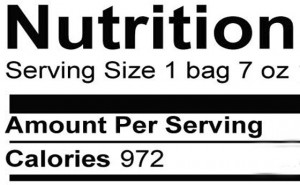 When deciding how much foods to add to your emergency supply, the most important rule to remember is to go by CALORIES, not by serving size.
When deciding how much foods to add to your emergency supply, the most important rule to remember is to go by CALORIES, not by serving size.
Here’s how and why…
Food companies and manufacturers (and emergency food companies) have different definitions for what constitutes a serving.
Remember when choosing your emergency foods,
to look at the total calories, and/or the calories in what they consider a serving.
If the package/can/etc.. is considered 1 serving, then check how many total calories.
If the package indicates that it contains 4 servings, then read the fine print…
If they list the calories-per-serving, then multiply by 4 for the total number of calories in the package.
If they simply list total calories, and they call it 4 servings, then they are saying that each serving is only the total divided by 4.
The marketing can get tricky, so be careful. Survival is about total CALORIES, not the number of servings.
Many people make the incorrect assumption that a serving size should contain enough calories for a complete meal. In truth, there are no standards for serving sizes; they are only suggested portions by the manufacturer.
Focus on the amount of calories in the whole package instead of the number of servings per package.
For example, don’t expect an entrée meal of a typical emergency food package to contain enough calories to complete your calorie intake. Look into supplementing it with other foods, snacks, drinks, fruits, vegetables, rice, etc.. and other food items to help increase your daily calories. Having a variety of foods to eat creates normalcy in an emergency situation.
How many calories do you need each day? A hard work day cutting down trees and moving storm debris will require more calories than sitting around all day. When planning, it’s best to assume you will need more calories than less. In general, teenage and adult males may need 2800 calories per day, while teenage and adult females may require 2200, and children 13 and under may use 1400 calories.
Going by these figures, an adult male needs more than 900 calories per meal, assuming three meals per day, for an active lifestyle.
How many calories do you need for emergency food storage? The first step is to figure out how many total calories you and your family consume on a daily basis.
Next multiply that by the number of days for which you want to be prepared.
This becomes the minimum number of calories that you need to have in your food storage program.
Decide how many months worth of food you want. This is influenced by your personal comfort level. The longer period of time you can supply for the better, but most people can’t afford to go out and buy a year’s worth of food without some prior planning and budgeting.
The best recommendation is to start where you can. First build up a 2-week supply and then move to 30 days’ worth. Once you have that, work up to three months, then six and then a year. Build up your food storage supply as big as you need in order to feel safe and to be able to provide for your family in any disaster situation.
Source:http://modernsurvivalblog.com/preps/emergency-food-storage-is-about-calories-not-servings/
